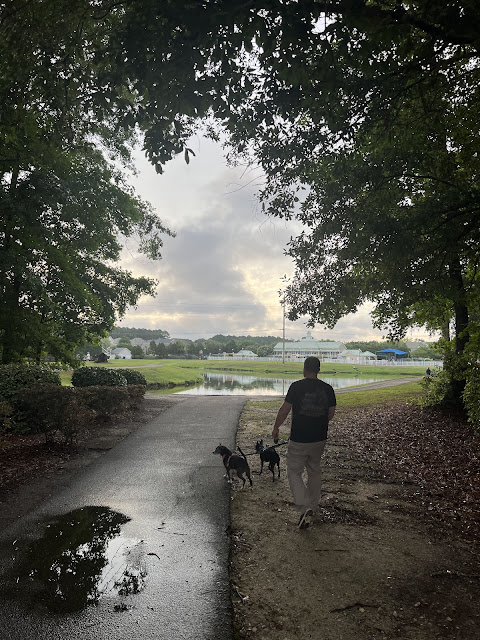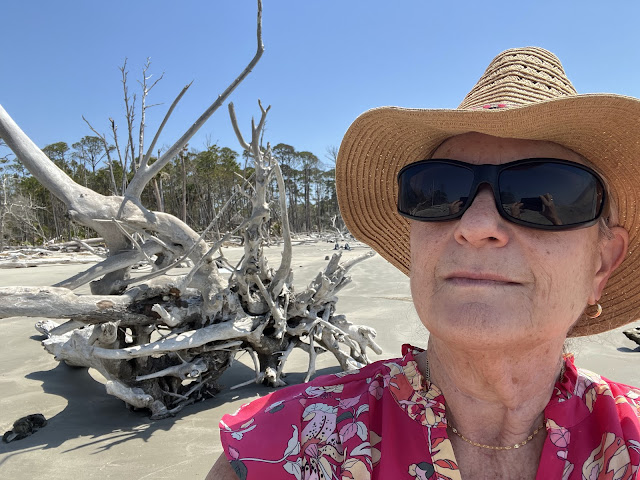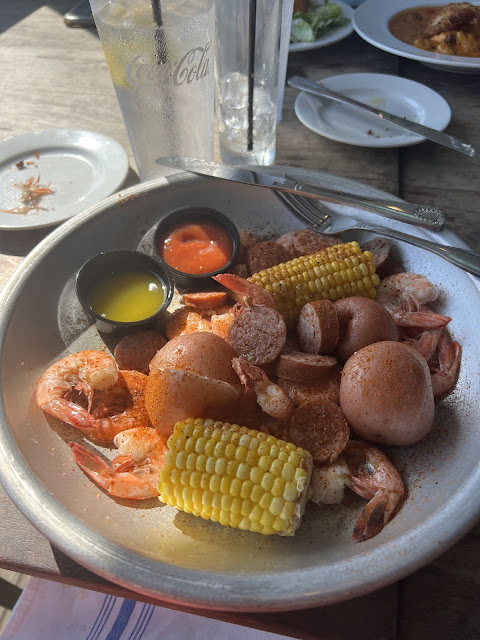 |
Town Square in Summerville has a nice park in the middle
It was the second week of our visit to the Summerville home of our son Jake and daughter-in-law Cora. Keith and I were mostly on our own during the day while they both worked although Jake had a home office. It was a time we explored more of what Summerville had to offer and we found it friendly and interesting. Around the town square were many small shops and the Historical Museum where Cora's father volunteered one day a week as a tour guide. There was so much to learn about the town and its relationship to Charleston close by. This was the place that people came to get away from the hot city for fresher air and good health benefits that were first believed to be influenced by the pine trees. It was on higher ground unlike the lowland where mosquitoes thrive more. It was the place to be in the summer so they called it Summerville. Keith and I enjoyed Gary's two-hour presentation and took him to lunch afterwards to the Crystal Ice House Restaurant next door. The converted old ice house was different and a fun atmosphere in line with the history. It is a cool place!
|
 |
| Gary at The Crystal Ice House Restaurant |
 |
| Fruit Salad with Grilled Shrimp at the Crystal Ice House Restaurant |
One evening after the kids were done with their work, we all went out to eat at the nearby Shuckin' Shack Oyster Bar. I had some good Fish 'n Chips. It was a lively place! Later we walked around the square and found the Guiness Book record-breaking "World's Largest Sweet Tea" displayed. How much more "Southern" can you get? |
| Shuckin' Shack Oyster Bar |
 |
| World's Largest Sweet Tea Attraction with Beti & Keith |
 |
| Beti in Downtown Summerville at Dusk |
Several times a day, Jake would take a break from his home office work and walk the dogs Angel and Finn around the ponds in the wooded area across the street from his home. This is also the area around the Clubhouse and beautiful pool I spent several afternoons. Sometimes Keith or I would join our son on his walks. Sometimes Keith would go fishing in the ponds. |
| Jake with Finn & Angel on an evening walk around the local ponds and pool area |
 |
| Clubhouse & Pool |
One evening we all got together with both Cora's parents Esther & Gary and her two brother, Bill & Andrew who all live in Summerville for a nice family dinner in their beautifully decorated home. Cora cooked a delicious spaghetti dinner! It was a memorable time filled with good food and drink, conversation, and family love. The rest of the evening was enjoyed outside around the fire pit with more wine. |
| Dining Room set for family dinner |
 |
| Kitchen Area |
 |
| Family Dinner with Jake, Cora, Ester, Gary, Bill, Beti, Keith, & Andrew |
 |
Fire Pit relaxation after family dinner
When the weekend came, the plan was for a day-long expedition which involved about an hour drive to the St. Helena basecamp near Beaufort. While we waited for our boat to be ready, we saw some unusual carnivorous plants such as the Venus Flytrap and some Pitcher Plants. They did eat a bug as we watched! Then we went about an hour by boat to a remote St. Phillip's Island which is near the US Marine Paris Island military base. On the way, we saw a couple alligators, many sea birds, and the different plant life that were all pointed out to us. After we docked at St. Phillips Island, we boarded a Tram that drove us about 30 minutes through a very rough road located in the swampy wetlands. We could have gotten off at anytime to explore other trails that were points of interest. The mosquitoes were so numerous that they could keep up with the Tram when it slowed down on the road. We were told there were poisonous water snakes, and any number of creatures in addition to alligators that we were not to disturb but could observe. No one in our group wanted that experience so we were let off on the beach known as "the boneyard" because of all the driftwood washed up on the shore. The Tram was to come back and pick us up in a couple hours and the boat would return to take us back to the basecamp. We didn't want to miss any of these pickup times so a few of us set our phone alarms. Not a great place to be left behind! I did experience a great feeling of real isolation and I liked it...for a couple hours with family.
First thing, we set up our picnic spot on the beach. Everyone went exploring along the shore and walked a little ways into the gentle waves. It was so calming and pleasant. So many shells to view and most creatures were still alive inside! This place was unlike any other I have experienced with its isolation and natural pristine beauty with a hint of danger! |
 |
| Entrance to Coastal Expeditions at St. Helena Basecamp |
 |
| Venus Fly Trap and other other carnivorous plants were to be found here |
 |
| Keith, Beti, Cora & Jake at the dock |
 |
| Off we went for an hour ride to remote St. Philips Island |
 |
| On the way we saw alligators and a variety of seabirds |
 |
| St. Philips Island Sign |
 |
| Boat Dock |
 |
| Tram from boat dock through swampy wetlands to seashore |
 |
| Pano view of beach area for our picnic |
 |
| So much interesting driftwood on the beach they call it the boneyard |
 |
| Jake finding many sea creatures in the water close to shore feeding |
 |
| Many shells are alive! |
 |
| Many of these little shells are trying to find there way back to water |
We had a meal at the 11th Street Fish Camp with a waterfront location and view. It was a more upscale fish camp than typical that can commonly found along the coast; mostly in campsites for fishermen and very casual family friendly dining areas where one can get the fish caught that day cooked for them. Seafood Boils are popular which is a one-pot meal with one or more kinds of fresh seafood, new potatoes, corn on the cob, sausage boil-cooked basically with a seasoning like Old Bay. So many delectable desserts to chose from! I choose the Key Lime Pie. |
| 11th Street Fish Camp near Point Royale |
 |
| Shrimp Boil |
 |
Variety of desserts - I had the Key Lime Pie
Before we left the Point Royal area, we stopped for gas as it was about an hour drive back to Summerville. I happened to look out the window and saw a large number of white birds in the trees and wanted to check it out. So I got out of the car while they were pumping gas and said to please pick me up across the street. What I saw was amazing! Everyone joined me as we took time to walk around the Point Royal Cypress Wetlands located right in town. I am so glad that we all took the time to see all the nesting seabirds and reptiles! |
 |
| Map & Guide available on walkway |
 |
| Identification Information Board on Trail |
 |
| Warning Sign along walkway. See the alligator in the water? |
 |
| Turtle |
 |
| Alligator viewed from walkway bridge |
 |
| Alligator viewed from walkway bridge |
 |
| Nesting Birds |
 |
| Trees are really full with nesting birds and the sound of them is VERY loud! |
 |
| Nesting Bird |
 |
| Walking on the bridge is a great way to view many perspectives of the wildlife in and out of the water |
Needless to say, we were all very tired at the end of this adventurous day! I am so happy to have shared this experience with family!
Stayed close to Summerville for the rest of the week to enjoy doing some of the same things mentioned before. We had two more meals out in local restaurants after the kids got off work- a Ramen restaurant and Bexley Fish and Raw Bar. Then enjoyed the beautiful plants in the yard that were showing their best colors. I was starting to miss my own gardens at home in Missouri as I left them two weeks ago in great shape and knowing we had lots and lots of rain since we left. I knew they would be lush when we get back home and Bobi Kitty can get back in his catnip patch after being boarded for two weeks at Kira's Pet Retreat. What wonderful memories we brought back!
 |
| Spiral Planter - notice the pine needle mulch! |
 |
| Rubeccia & Heather |
 |
| Pansies planted with the Jasmine tower |
 |
| Magnolia Trees |
 |
| Lily |
 |
| Jasmine blooms smell wonderful! |
 |
| Blooming Garlic |
 |
| Elephant Ears |
 |
| Chameleon |
 |
| Strawberry Towers - I helped plants several of these! It will include lettuces and greens also. |
 |
| Zinnias & Sea Oats |
 |
| Back in Missouri, Bobi Kitty finds his catnip has grown a lot in 2 weeks! |
THERE'S NO PLACE LIKE HOME!
























































